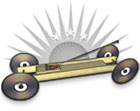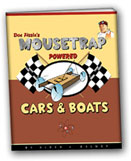Mouse Trap Cars: Braking System
Learn how to make an accurate and adjustable braking system that can be attached to your mousetrap powered vehicle in order to bring it to a stop at any distance.
One of the more popular mousetrap vehicle contest is to design a mousetrap powered car that travels as fast as possible and then stops closest to a finish line or a target. This contest requires the builder to designing a braking system that will be deployed at the correct distance causing the mousetrap racer to come to an instant stop. Not only will a builder have to design a braking system but also think carefully about the overall design of the vehicle in order to make sure the vehicle is fast off the start but also that it has the traction required to make sure the vehicle does not skid past the target once the braking system is applied.
Lock-Tight
Lock-Tight is just one of the many kits manufactured by Doc Fizzix Products. Lock-Tight has an onboard braking system that is extremely accurate to 1 centimeter of any target distance. Lock-Tight's braking system uses a wing nut that travels along a threaded axle until it locks tight against the frame of the vehicle causing the mousetrap racer to come to an instant stop. Setting Lock-Tight's braking system is simple and easy, just place the vehicle at the finish line with the wing nut in the locked position, then roll the vehicle back to the start line to sets the wing nut in the exact starting position needed. Lock-Tight also comes with two rubber treads that are designed to increase the stopping traction helping the racer to come to a stop without skidding
Lock-Tight: Lock-Tight uses a high-tech wing-nut locking-system that travels along a threaded axle and then wedges against the frame bring the racer to an instant stop.
Braking Systems
There are a variety of different braking systems that can be used to stop a mousetrap vehicle at a set distance, the string method and the lock-nut system are highlighted in this article.
String-Method
The string method is easy to employ and can be accurate over short distance but are not very accurate over long distance and is not very adjustable when the target distance changes. The biggest problem with the string system is caused by an uneven winding of the string around the brake axle. On one test run the braking system may work perfect but then on the next test run the string may wind a little bit differently than before causing the mousetrap vehicle's stopping distance to change. It is also hard to re-adjust the braking system for different stopping distances; in this case, you basically have to make a new length of string for the new stopping distance. For an easier to adjust and more accurate braking set-up see the lock-nut system.
The idea with the string methods is to use a set length of string that will wind around a brake axle until the target distance is reached and then the string will trigger some type of brake or stopping mechanism. The string can be first wound around a spool and then transfused from the spool to the axle one until the string is used up. When the string runs out, there is some type of lever system that releases a spring loaded brake against the vehicles wheel(s) as pictured bellow.
bonus tip: a string is used to release a lever that employs a brake bar against the wheels of the vehicle.
Another string method can be set-up so that the string, with a washer tied to the end, is pulled through a metal loop and drags behind a mousetrap car. The string is also tied to one of the axles and is pulled closer to a lock that will stop the brake axle from turning. When the correct travel distance is reached based on the target, the string pulls the washer against the lock and stops the wheels from turning.
bonus tip: a string is pulled along like a tail by one of the axles until the target distance is reached and then the string can not be pulled any further.
Lock-Nut System
The lock-nut system is by far the most accurate braking system that can be used. The lock-nut braking system uses a wing-nut that travels along a threaded axle. As the threaded axle turns a wing nut travels along the threaded axle until it lock tight against the frame of the vehicle, or the axle, causing the vehicle to come to an instant stop. Setting the braking system is simple and easy: just place the vehicle at the finish line with the wing nut in the lock position, roll the vehicle back to the start line and the wing nut is set to the exact starting position. Now you are ready to go. The wing-nut braking is very accurate and consistent but the best part it that it can be set for almost any distance by following the same steps as described.
bonus tip: The lock-nut braking system uses a wing-nut that travels along a threaded axle and then wedges it's self against the frame of the vehicle t the correct distance.
high-Tech set-up: The Doc Fizzix high-tech braking system comes with a threaded axle, wing nut, locking-bay, and complete step-by-step instructions.
Setting The Brake
Setting the lock-nut braking system is simple and easy, just place the vehicle at the finish line with the wing nut in the locked position, roll the mousetrap vehicle back to the start line, and this sets the wing nut to the exact starting position needed. This easy to set braking system can be repositioned for any length course by repeating the described procedure.
step #1: Place the wing-nut in the locked position then place the vehicle at the finish line.
step #2: roll the vehicle back to the start line and this sets the wing-nut to the correct position for the course.
Adding Traction to Wheel
Adding traction to a wheel will give the wheel more grip and greater stopping potential. One way to increase the traction of a wheel on smooth surface is to add a rubber traction tread that has more grip than the original wheel alone. Various brands of rubber may have more grip than another brands of rubber so it is always best to experiment. Rubber bands can be stretches and placed directly over a wheel or the middle section of a balloon can be cut and then also stretch around a wheel to help increase the traction. The balloon trick should not be used on Doc Fizzix DVD-layers.
step #1: cut the center section of a rubber balloon as pictured.
step #2: stretch the cut section of the rubber balloon around the CD/DVD.
alternate option: rubber bands can also be stretched around a wheel to increase the traction.
Ultra Stick Foam Wheels
Doc Fizzix's Ultra Sticky Foam Wheels are made from a lightweight urethane that is specially designed to grab the road and provide maximum traction for maximum acceleration and stopping. While the rest of the field is spinning their wheels at the start line or skidding past the finish, your racer will be rocket to the perfect finish. These wheels are manufactured specifically for Doc Fizzix Products and are the same wheels that were used on Doc Fizzix's world record setting mousetrap racer that traveled 5 meters in under 1.2 seconds. By far, the biggest secret to Doc Fizzix world record setting speed-trap racer was the use of the ultra sticky foam wheels that were essential in keeping his Speed-Trap Racer from spinning out at the start line and providing maximum traction to the road. Ultra sticky foam wheels are 2-inches in diameter and machined to fit a 5/32-inch axle.
bonus tip: ultra-stick foam wheels gives all the traction you will need for quick accelerations and instant stops..
*Can't find what you're looking for? Ask Doc Fizzix »




